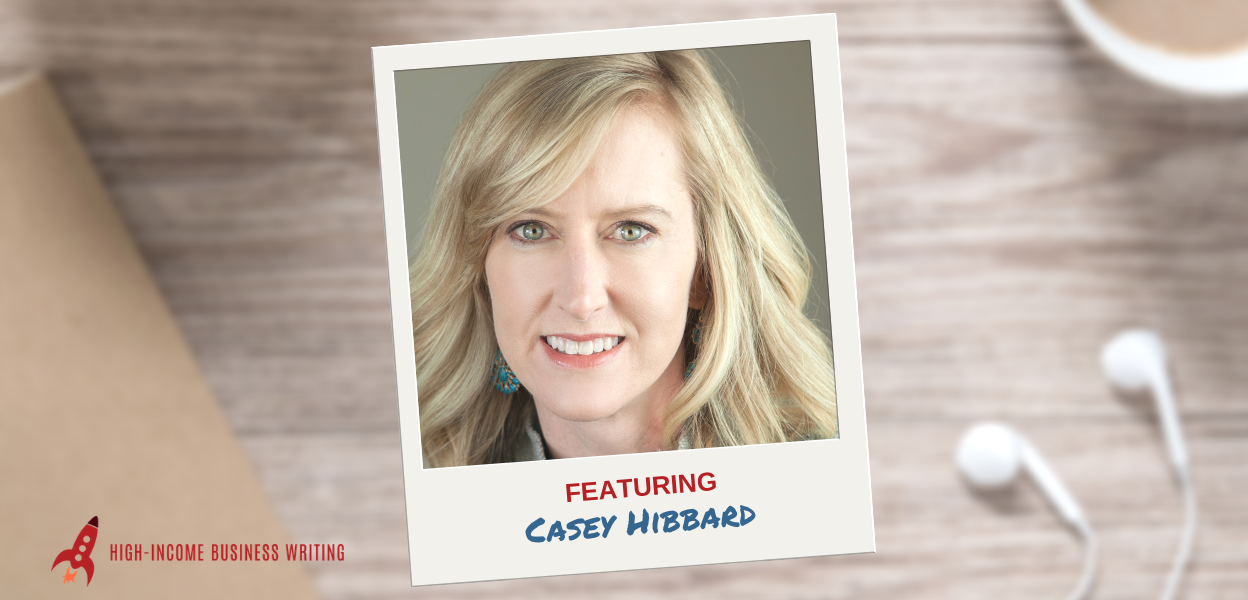Casey Hibbard is one of the best and most prolific case study writers in North America. She’s been writing case studies for 20 years and has been focusing exclusively on case studies for much of that time.
Casey was one of my first guests in this podcast. In that interview she discussed the opportunity in writing case studies and why it’s a great way to consistently earn $200 (or more) an hour as a writer.
With her 20th business anniversary, I asked Casey to come back on the show and share some of the most important lessons she’s learned after writing hundreds of case studies for dozens of companies.
In this interview, she shares five valuable tips that will make you a stronger case study writer and help you command higher fees for these fun projects. These tips are pure gold, and I hope you enjoy them.
The notes that follow are a very basic, unedited summary of the show. There’s a lot more detail in the audio version. You can listen to the show using the audio player below. Or you can subscribe in iTunes to get this show delivered straight to the Podcasts app on your smart phone, tablet or iPod.


High-Income Business Writing with Ed Gandia
#171: Five Valuable Case Study Tips from a 20-Year Case Study Veteran
Tell us about yourself
Casey Hibbard has been a copywriter for over 20 years. Today, her business is almost exclusively focused on customer case studies and related “voice of the customer” content.
She works mostly with tech companies.
How did you get into writing case studies?
About a year into her business, a client asked her to write a case study. She wasn’t sure what that was. But once she got into it, she decided this is what she wanted to do. For her, it was the perfect mix of journalism and marketing.
About two years in, she changed all of her marketing messaging to focus on case studies. She continued to do other types of work at times, but eventually she shifted her entire business to case studies.
What are your most important tips for case study writers?
1. Tell a unique story every time
You want every story to be unique. But this isn’t always easy when every customer tells a similar story.
The way to differentiate those stories is through questioning. Sometimes you have to get very specific. For example, to get an anecdote, you can ask:
- “Tell me about a time when you knew things had to change”
- “Talk about the frustrations you had with your previous system and the impact on your business”
- “Tell me about a time when it was clear that things had changed for the better”
You want customers to elaborate on their experience. When you get these kinds of details and anecdotes, you get a deeper, more unique story.
One of the secrets of writing a good case study is to solicit anecdotes.
2. Ask specific, open-ended questions
You can’t build a compelling case study on short answers. You can’t do much with “It’s great! We like it.”
Not everyone is talkative. So you need to ask specific, open-ended questions.
So instead of asking “What benefits have you seen with the product/service” you can ask “How much time did invoicing take before? Why was that a problem? How much time does it take now? What does that mean for you?”
Customers often need this level of specificity because they don’t know what you’re looking for.
It’s always a good idea to have backup questions in case your first set of questions doesn’t get the responses you want.
You can say something like, “The last customer I talked to said they cut four days off their invoicing process with this system. Is that what you’ve experienced?” The customer can then confirm, deny or clarify.
Do you send your questions to the customer ahead of time?
Sometimes. It can be helpful to let them know in advance what you’ll be talking about.
But make it clear that they’re not to complete the questionnaire. You’re sending it as a heads up. It’s not a replacement for the live interview.
And you need the live interview to dig deeper and get authentic quotes.
3. Check the story against the client’s goals
Your case study will be a sales and marketing piece for your client. So you want to make sure they’ll get what they need.
Casey will use a discovery process to find out what clients want in the final case study. Often she’ll ask, “What would be in the perfect case study?”
Of course you’re limited to whatever the customer says. But you can tailor your questions to help get what your client needs.
4. Make it human
Case studies are unique in marketing because they feature real people. That’s what makes them interesting.
If you can capture human emotion in your quotes (e.g. frustration, excitement, relief) then it makes the case study much more compelling.
So Casey will say, “Talk about some of the pains and problems you were having before you made the change.”
Tangible results in case studies are great. But don’t forget to color them with human emotion.
5. Get permission up front
Unlike other types of marketing content, customers have to agree to participate in case studies. They also have approval over the final story.
Therefore, it’s always wise to ask your client and their customer whether permission has been obtained. The customer contact might be fine with it. But their marketing and legal departments might have other ideas.
How are case studies changing? Are there any important trends we should be paying attention to?
Generally, case studies are getting shorter. Clients don’t want anything longer than two PDF pages. That’s about 800-900 words. (Less if you have large images.)
Infographics are increasingly popular. Working with a designer, you can use your case study as a source for these.
Other opportunities for related content are blog posts and sales slides that draw from the case study.
Casey has seen some companies create two versions of a case study. One is greatly abbreviated and used as a web teaser.
Tell us about your book Stories That Sell
Casey’s book walks writers and organizations through all stages of case study creation.
She also has some free resources on her website.
Where can listeners learn more about you?
Casey’s book, Stories that Sell
By the way … whenever you’re ready, here are 4 ways I can help you grow your freelance business:
1. Grab a free copy of my new book for writers who are NEW to freelancing.
It’s called “The 3 Magic Levers: How to Get Your Writing Business Off the Ground and Land Your First Paying Client.” — Click Here
2. Download a free copy of my book for ESTABLISHED writers/copywriters.
You’ll discover how to quickly and predictably reawaken dead leads, generate new client opportunities and convert not-yet-ready prospects into freelance writing clients. — Click Here
3. Join our “Get Better Clients Academy”
You’ll get a personalized action plan based on where you are today in your business. Plus all the tools, scripts, checklists, cheat sheets and templates you’ll need to escape feast-or-famine … grow your income … and land clients who love and respect you. — Click Here
4. Get your website DONE!
If you’ve been struggling to get your website done … or if you’re not happy with what you’ve got today… let my team and me build you a beautiful website for your writing business. We’ll do all the hard work! Email me at ed@b2blauncher.com … put “WEBSITE” in the subject line … and I’ll reply with the details.






